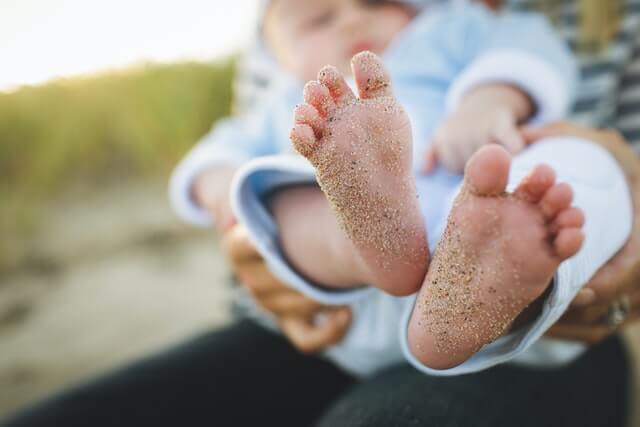Children’s feet need care and attention throughout their development. Here’s some essential podiatry tips for each stage of their growth.
Babies’ and children’s feet differ from those of adults, as they are not yet fully formed. At six months of age, the foot is still mostly cartilage. The last bone doesn’t begin to form until children are about three years old. By 18 years, most of the bones are fully formed.

Babies’ feet
Baby feet only need protection in the cooler weather. Grow suits with feet, socks, or small, soft natural fibre shoes should be used to keep little feet warm and should always be loose around your baby’s feet.
Making time for your baby to kick freely will help develop the muscles in the legs and feet.
Beginning to walk
Children also roll, crawl, walk and run in their own time; there is no evidence to support the view that the use of Jolly Jumpers or baby walkers will help this to happen early. These types of equipment may put additional pressure on feet that are not yet ready for taking weight.
When your child first begins to walk, shoes should only be used when protection is needed from the ground. Allowing children to go barefoot or wear very soft shoes helps the foot develop and helps strengthen muscles.
Sometimes children walk with their feet pointed inwards (in-toeing) or outwards (out-toeing). In most cases, these variations in walking are normal. Most children will grow out of these walking styles by the age of two; however, it can sometimes take until they are 12. If your child is not keeping up with their friends, a podiatrist may be able to assist.
Children under the age of three may sometimes walk on their tiptoes, which is a typical developmental stage. A podiatrist should assess any child over three who is still walking on their tiptoes (toe walking).
Growing feet
 A child’s foot grows in length and changes in shape with growth. Arch development is an individual thing, and arch height or a lack of an arch does not always indicate that a child will have problems with their feet. If your child has pain or has one flat foot that differs from the other foot, a podiatrist can assist.
A child’s foot grows in length and changes in shape with growth. Arch development is an individual thing, and arch height or a lack of an arch does not always indicate that a child will have problems with their feet. If your child has pain or has one flat foot that differs from the other foot, a podiatrist can assist.
Due to rapid growth in length and width while young, frequent changes in the size of shoes and socks may be necessary. Do a size check at least every one to three months up to three, every four months up to five and every six months from five years.
Heel pain
Heel pain may also occur in growing children, usually between the ages of eight to14. It may be worse during or straight after sporting activities.
If your child is experiencing pain at the back of the heel that has limited their activity or causes them to limp, a podiatrist may be able to help. Your podiatrist may be able to determine whether or not the heel pain is related to the developmental process and give advice on ways to alleviate symptoms.
Skins and nails
Problems with the skin and nails on your child’s feet may occur from time to time. Some conditions (ingrown toenails, Athlete’s foot and warts) require treatment from a podiatrist. Alternatively, others may be helped by changes in hygiene or shoes.
Children also tend to be more susceptible to warts than adults. A plantar wart is often on the sole and appears hard and flat, with a rough surface and well-defined boundaries. If the wart is causing discomfort, a podiatrist can assist with treatment.
Children’s Footwear
Above all, shoes should protect your child’s feet. When fitting your child’s footwear, keep the following in mind:
- Always have both feet measured for length and width
- The shoe should fit the natural shape of the foot, especially around the toes
- The toe of the shoe should allow toes to move freely and not be squashed from the top or the sides Make sure there is about 1cm growing room for children between the end of the longest toe and the end of the shoe.
- Shoes should fit comfortably around the heel and not be too loose or too tight.
- Having shoes fitted by a store that offers trained assistants can help ensure the correct size and shape to keep little feet running and jumping.
Professional podiatry advice for children
We recommend a check-up with a podiatrist if:
- You notice uneven shoe wear
- You notice any skin rashes, hard skin, lumps or bumps on your child’s feet
- Your child complains of recurrent pain in the feet and/or legs which also increases with activity
- Your child is constantly tripping or falling
- Your child walks on their tip toes
- Your child’s walk does not look symmetrical (or the same on both feet and legs).
- Or you have any other concerns about your child’s feet
Severs Disease
Severs Disease is a painful condition where the calf muscle/Achilles tendon pulls away from the heel bone growth centre, causing an inflammatory response. The problem is usually self-limiting (meaning it will resolve on its own). However, this may take years.
Treatment can help hasten this recovery process and should start as soon as possible Early intervention helps prevent the child from enjoying activities such as group and class sports during this critical developmental stage.
Although each child is different, usually, subtle biomechanical problems exacerbate the traction and pain that cause Severs Disease. We typically see a significant pain reduction and a return to sport within weeks by addressing these problems. Performance Podiatry uses video gait assessment software to identify these mechanical problems.
Plantar Warts
Plantar warts are common in children and can be painful if they are in a weight-bearing zone like the heel, the ball of the foot or between the toes. They are also common on the hands but look different because they grow outwards instead. Virtually everyone will have a wart (or several) someplace at some time in their lives.
Warts are noncancerous skin growths caused by a virus in the top layer of the skin. The culprit is a strain of virus called human papillomavirus or HPV. They manifest as a peculiar looking patch of hard skin that usually goes ‘in’ when on the bottom of the foot. Although, on other areas, warts usually pop ‘out’.
Most warts are about the size of a pencil eraser, but some grow bigger, and sometimes warts can grow in clusters; those are called mosaic warts. In some warts, little black dots appear – blood vessels that have grown up into the wart. If you try to shave a wart off your skin, it will bleed a lot.
At Active Podiatry, we have a highly effective wart killing solution that will remove the wart in just one or two treatments. Better still, it doesn’t hurt, so children need not get stressed by the treatment.
If a wart is not painful then you can just leave it alone and it may disappear on its own, thanks to the immune system.
